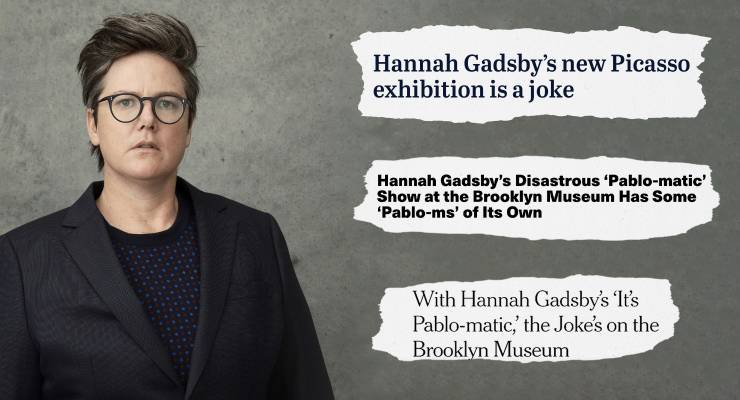
In Hannah Gadsby’s standup special Nanette — essentially the world’s least successful resignation letter, propelling its creator to international stardom and a string of other stand-up shows — the comedian’s qualifications in art and their disdain for Pablo Picasso produces the memorable line that Cubism was simply the product of Picasso’s decision to “put a kaleidoscope filter” on his penis.
Five years later, we get It’s Pablo-matic: Picasso According to Hannah Gadsby — “It is a title so silly that I cannot even type it; I am cutting and pasting,” writes The New York Times — and by God does everyone seem to hate it. From inception to resolution, almost none of the art critics to review the exhibition has a good word to say about it.
Even before the show was available to be reviewed it was getting bad notices on account of the connection between the Brooklyn Museum, where it was to be housed, and the Sackler family. The same Sackler family which just paid a US$6 billion settlement in lawsuits linked to the US opioid crisis that it built its wealth on.
“I was assured that [Elizabeth A Sackler, who is on the Brooklyn Museum board] separated from the opioids strain,” Gadsby said at the time. “That’s where it lands. I don’t see it as a clean win-win. That’s for sure, but I’m not sure how to navigate this world.”
What’s the big idea?
There is perhaps no wider consensus in art circles than the dual observation that Pablo Picasso is well regarded as an artist and also a vile misogynist in his personal life. Thus much of the criticism of the show stems from the fact that Gadsby (and co-curators Catherine Morris and Lisa Small) appear to believe the observation is sufficiently provocative and original enough to sustain the show. As Jason Farago writes:
All the feminist scholarship of the last 50 years — about repressed desire, about phallic instability, or even just about the lives of the women Picasso loved — is put to one side, in favor of what really matters: your feelings.
…
That Picasso, probably the most written about painter in history, was both a great artist and a not-so-great guy is so far from being news as to qualify as climate. What matters is what you do with that friction, and It’s Pablo-matic does not do much.
The New York Times
The show collects a few Picasso paintings and sculptures surrounded by the work of contemporary feminist artists, but the reasoning behind the selections appears arbitrary:
It’s key that the show repeatedly references [Françoise] Gilot and [Marie-Thérèse] Walter, as well as other women from Picasso’s love life, like the artist Dora Maar and the dancer Olga Khokhlova. These women were previously written off as Picasso’s ‘muses’, and It’s Pablo-matic suggests that historians still have trouble talking about them. While the show is frank about the negative aspects of these women’s relationships with the artist, they are always discussed within the context of Picasso, who continues to exert a strong gravitational pull.
I detected a disingenuous sentiment amid it all. Gilot and Maar both produced art of note. Where was that in this show? It would’ve been instructive to see their work placed on equal footing with Picasso’s.
ARTnews
The lack of any interplay produces a paradox — an exhibition that argues Picasso “takes up too much space” in art history, and then centres him in relation to the work of women that bears no particular influence, positive or negative, of his work. Thus he is also spared any of the meaningful critiques that are widely available:
For this show the reactions came first, the objects reacted to second … A show properly engaged with feminism and the avant-garde might have turned to Lyubov Popova, Natalia Goncharova, Nadezhda Udaltsova or Olga Rozanova: the remarkable Soviet women artists who put Picasso’s breakdown of forms in the service of political revolution. A more serious look at reputation and male genius might have introduced a work by at least one female Cubist: perhaps Alice Bailly, or Marie Vassilieff, or Alice Halicka, or Marie Laurencin, or Jeanne Rij-Rousseau, or María Blanchard, or even Australia’s own Anne Dangar.
The New York Times
The Jokes
Gadsby affixes little gags alongside Picasso’s works, but it’s unclear to reviewers what purpose that serves:
Gadsby simply can’t be bothered, or lacks the skills, to present a thorough and illuminating explanation of Picasso’s shortcomings as an artist and person. They’d rather make high-school-level comments about how Cubism is akin to ‘putting a kaleidoscope filter on your dick’ and belittle the potential for art to meaningfully impact the world.
The Sydney Morning Herald
There’s a fixation, throughout, on genitals and bodily functions. Each sphincter, each phallus, is called out with adolescent excitement; with adolescent vocabulary, too. What jokes there are (‘Meta? Hardly know her!’) remain juvenile enough to leave Picasso unscathed.
The New York Times
‘Picasso once said it took him four years to paint like Raphael, but a lifetime to paint like a child,’ Gadsby writes in the wall text. ‘Well, I don’t want to call myself a genius … But it did only take me four years to be as funny as Raphael.’
‘Funny’ is debatable, but comedy is used as a curatorial device throughout the show. Gadsby’s quotes, which are printed above more serious art historical musings, are larded with the language of Twitter. ‘Weird flex,’ reads one appended to a Picasso print of a nude woman caressing a sculpture of a naked, chiseled man. ‘Don’t you hate it when you look like you belong in a Dickens novel but end up in a mosh pit at Burning Man? #MeToo,’ reads another that goes with a print showing a minotaur barging into a crowded, darkened space.
ARTnews
Meta-criticism!
Even the curators’ response to the overwhelmingly critical coverage they’ve received has been badly reviewed:
In response to scathing reviews from The New York Times and ARTnet, Brooklyn Museum curators Lisa Small and Catherine Morris posted a selfie with the caption ‘that feeling when IT’S PABLO-MATIC gets (male) art critics’ knickers in a twist’, as if the exhibition is being panned because it’s speaking truth to power and is too radical in its messaging. To the contrary, the show has little to say, bar that Picasso was a bad guy and that good women artists exist.
The Sydney Morning Herald








Newsflash. Maybe not everything Hannah Gadsby does is great, or enjoyed by everyone.
Can’t speak for her art ability.
As a comedian she was about as funny as a squashed dog on a road.
In your opinion. Not in mine nor many others. Funny about that, huh?
Everyone is entitled to their own opinion. no matter how wrong it may be. No?
I’m entitled to my opinion. My opinion is that you’re wrong, but entitled to be wrong. Go for it.
It’s not jut his opinion. He doesn’t enjoy everything Hannah Gadsby does. Ergo, not everything she does is enjoyed by everyone.
And frankly, though it is opinion, not everything she does is done well.
I’ll admit I think Gadsby is overrated as a comedian so I bring some bias here, but I think the criticism of this exhibition has a lot of merit. Public galleries sit on huge, expensive collections of important cultural objects with a remit to provide access and context to the public. They should be places where serious scholarship happens, instead most are drifting into a kind of shallow shock entertainment underpinned by cheap identity politics. There are feminist scholars with decades of experience who would jump at the opportunity to assemble a show on Picasso, but they handed to a celebrity hack who responded to critics with cheap jibes about ‘men getting their knickers in a twist’. Brooklyn Museum is a major institution, not a comedy club. Gadbsy had nothing new to say, and what she did say was incoherent. At most, it should have been a 30 minute Netflix special … with a very short run.
I think she’s the best comic the country’s produced, and I think the furore she’s produced is a great achievement.
Hey she was better than Barry Humphries who wasn’t a comedian apparently.
“Barry Humphries loves those who hold power, hates vulnerable minorities and has completely lost the ability to read the room. That’s not a comedian, that’s an irrelevant, inhumane dick biscuit of the highest order” – (Hannah Gadsby)
Just a footnote. I read that Francoise Gilot had died this week at the age of 101. Picasso’s behaviour towards her, after she had divorced him, was truly awful.
“One of our most significant stand-up comedians”
no
Please share your definition of significance
Seriously, a downvote?
Pretty sure Nannette was the biggest thing ever, anywhere, for televised stand-up.
Nah, that doesn’t rate as significant
Oh she’s significant, but not as a comedian. Comedians are funny.
Art is, in part. meant to disrupt and confront. Critics’ knickers in knots? Mission accomplishment.